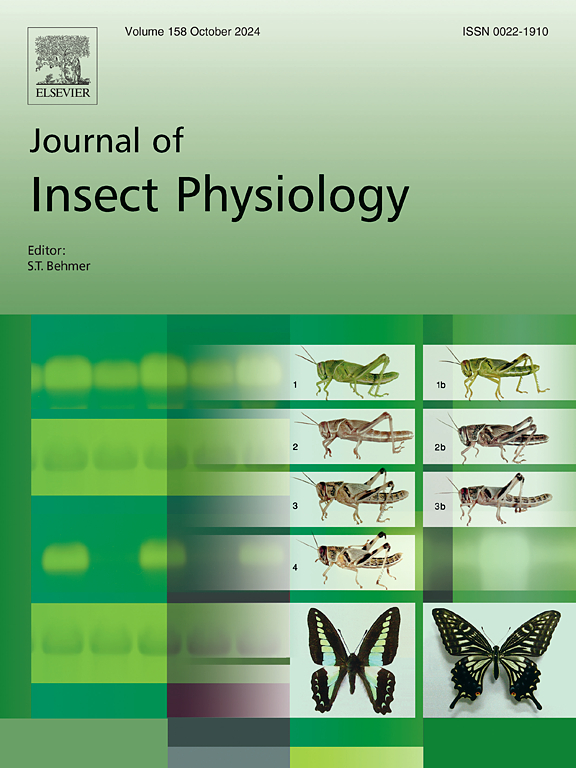Cinnabar-dependent eye pigmentation mediates light input for circadian behavior synchronization in Spodoptera frugiperda
IF 2.3
2区 农林科学
Q1 ENTOMOLOGY
引用次数: 0
Abstract
The fall armyworm, Spodoptera frugiperda, is a key lepidopteran pest of numerous agricultural and industrial crops worldwide. The effects of environmental factors, such as light, on the behavior of the fall armyworm have been poorly studied. Here, in this study, CRISPR/Cas9 was employed to generate a germline knockout of the eye color genes, cinnabar and cardinal. The homozygous cinnabar mutants (cin−/−) initially exhibited a pale-yellow eye phenotype, which gradually deepened to red over time, while wild-type with black compound eyes. The cin−/− were used for behavioral observations, indicating that adult mutants exhibited abnormal rhythmic patterns in eclosion, mating, and oviposition behaviors, suggesting that rhythmicity was significantly disrupted due to the loss of eye pigmentation. At two days post-eclosion observation of paraffin sections revealed that the pigment in the compound eye almost completely disappeared. Further, real-time quantitative PCR revealed that the expression of photosensitive and rhythm genes was completely disordered. These findings showed that the presence of cinnabar is essential for the color of the compound eye and is necessary for the fall armyworm to adjust the rhythms by sensing light through compound eye pigmentation, providing new insights into the relationship between eye and circadian rhythms in insects.
朱砂依赖性眼睛色素沉着介导了夜蛾昼夜行为同步的光输入
秋粘虫(Spodoptera frugiperda)是世界上许多农业和工业作物的主要鳞翅目害虫。光照等环境因素对秋粘虫行为的影响研究甚少。在这里,在本研究中,利用CRISPR/Cas9对眼睛颜色基因、朱砂和红衣红衣进行了种系敲除。纯合子朱砂突变体(cin−/−)最初表现为淡黄色的眼睛表型,随着时间的推移逐渐加深到红色,而野生型则具有黑色复眼。cin - / -用于行为观察,表明成年突变体在羽化、交配和产卵行为中表现出异常的节律模式,这表明由于眼睛色素沉着的丧失,节律性被显著破坏。羽化后2天石蜡切片观察复眼色素几乎完全消失。实时荧光定量PCR结果显示,光敏基因和节律基因的表达完全紊乱。这些发现表明,朱砂的存在对复眼的颜色至关重要,并且是秋粘虫通过复眼色素沉积感应光来调节节律所必需的,为昆虫眼睛与昼夜节律的关系提供了新的见解。
本文章由计算机程序翻译,如有差异,请以英文原文为准。
求助全文
约1分钟内获得全文
求助全文
来源期刊

Journal of insect physiology
生物-昆虫学
CiteScore
4.50
自引率
4.50%
发文量
77
审稿时长
57 days
期刊介绍:
All aspects of insect physiology are published in this journal which will also accept papers on the physiology of other arthropods, if the referees consider the work to be of general interest. The coverage includes endocrinology (in relation to moulting, reproduction and metabolism), pheromones, neurobiology (cellular, integrative and developmental), physiological pharmacology, nutrition (food selection, digestion and absorption), homeostasis, excretion, reproduction and behaviour. Papers covering functional genomics and molecular approaches to physiological problems will also be included. Communications on structure and applied entomology can be published if the subject matter has an explicit bearing on the physiology of arthropods. Review articles and novel method papers are also welcomed.
 求助内容:
求助内容: 应助结果提醒方式:
应助结果提醒方式:


